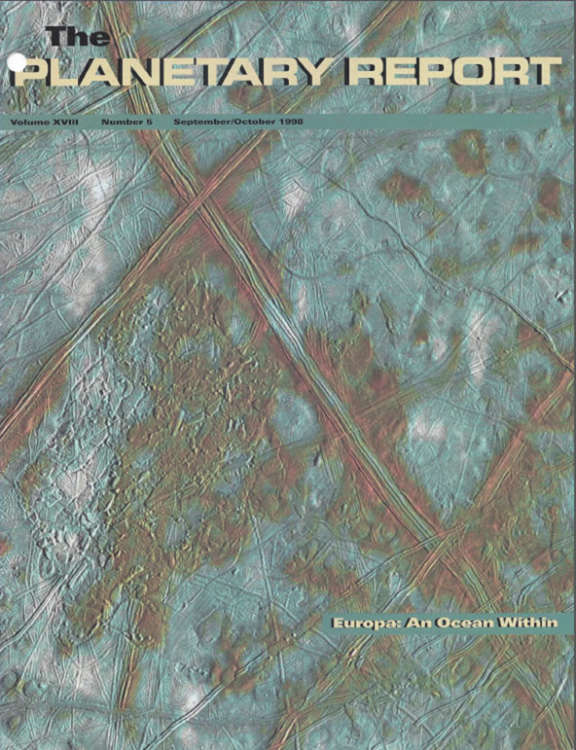The Planetary Report • September/October 1998
Europa: An Ocean Within
On the Cover: What sort of world is this? It's certainly one of the most tantalizing, bizarre, and beautiful worlds yet visited by spacecraft. And it is perhaps the richest in possibility. This is Europa, the world in our solar system most likely to harbor extraterrestrial life. We see it here in an enhanced-color image created from data gathered during three flybys. The colors, although exaggerated, do reflect the actual colors of Europa. The blue corresponds to icy plains, which are among the oldest temperatures on this moon. The reddish areas show where the water ice has been mixed with materials extruded from below. Bright white areas are ejecta rays of material blasted out by the impact that formed the crater Pwyll, which lies 1,000 kilometers (600 miles) to the south. These markings, superimposed on other features, are the youngest features visible in this region.
Features
4 Opinion: Striving Outward: Jim Burke speaks on why members of The Planetary Society vigorously support an endeavor as difficult and expensive as planetary science.
6 Backyard Bolides Finding a Buried Impact Crater: Geologist Wylie Poag explains how he happened to find a major impact crater buried beneath Chesapeake Bay.
9 Cosmic Dust: Evidence of a Comet Shower: Geochemist Ken Farley discusses how he and colleagues found evidence that a comet shower battered Earth 35 million years ago.
12 Europa: Layers of Mystery: Charlene Anderson showcases some of Galileo's fantastic images of Jupiter's fascinating icy moon.
Departments
3 Members' Dialogue The loss of Australia's NEO program; the search for life.
19 World Watch The Planetary Society's presence on planetary missions; progress on Mars Express.
20 Q&A How much water was on Mars?
22 News & Reviews Publisher's pressure; instant results.
23 Society News Red Rover, Red Rover hops on an asteroid!
The Planetary Report • September/October 1998
Help advance space science and exploration! Become a member of The Planetary Society and you'll receive the full PDF and print versions of The Planetary Report.


 Explore Worlds
Explore Worlds Find Life
Find Life Defend Earth
Defend Earth


